Beth Cato's Blog, page 141
August 28, 2013
Bready or Not: Crock Pot Honey Sesame Chicken
We've lived in Arizona for over six years, but there are still a lot of things we miss about our prior home near Seattle: the vivid green hills, the visible snow on the Cascades, the existence of winter, the cloudy days, Ivar's clam chowder, the teriyaki chicken...
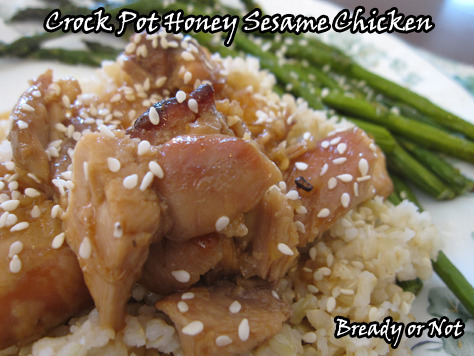
If you're not from around Seattle, that last point might come as a surprise. The simple fact is, almost every strip mall in that part of Washington has a teriyaki restaurant. These are the sort of mom-and-pop places that supply delicious meat by the bucket (i.e. a Styrofoam take-out box) and likely offer all sorts of other delights like sushi or gyoza, all of it addictive, affordable, and fast.
Around Arizona, it's easy to find good Mexican restaurants. Asian food... not so much. Therefore, when we get that craving for teriyaki, the best thing is just to make it at home. This recipe does the trick.
If only vivid green fields and soft rains could be conjured so easily...

Crock Pot Honey Sesame Chicken
modified from Table for Two
Ingredients:
1 lb boneless & skinless chicken thighs, about 5
Salt and pepper
1 cup honey
1/2 cup low sodium soy sauce
1/4 cup ketchup
2 Tb vegetable oil
2 cloves garlic, minced
1/2 cup diced onion or 1 Tb dry minced onion
1/4 tsp red pepper flakes
Cornstarch
Sesame seeds
Instructions:
1) Place the chicken thighs in the crock pot insert and sprinkle salt and pepper on both sides.
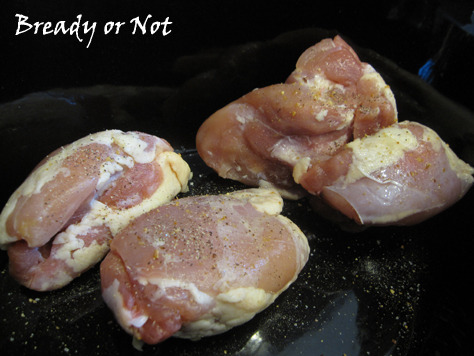
2) In a medium sized bowl, combine honey, soy sauce, ketchup, oil, garlic, onion, and red pepper flakes. Stir to combine. Pour over the chicken in the slow cooker.
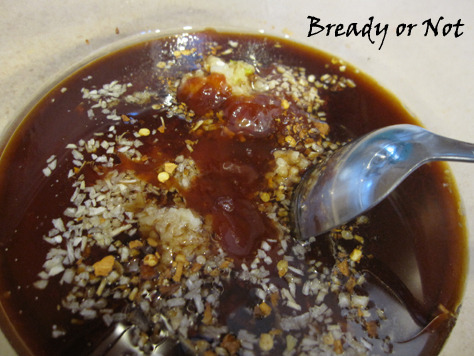
3) Cook on low for 3-4 hours or high for 1 1/2-2 1/2 hours. [I used the 4-hour HIGH setting, and my chicken was done in 2 hours.]
4) When done, remove chicken from crock pot and cut into chunks. Prior to putting the chicken back in the pot, combine some cornstarch in water and whisk it to thicken up the sauce. Throw the chicken back in and stir around to recoat the chicken.
5) Serve hot over a bed of rice or noodles and sprinkle some sesame seeds on top.
OM NOM NOM.
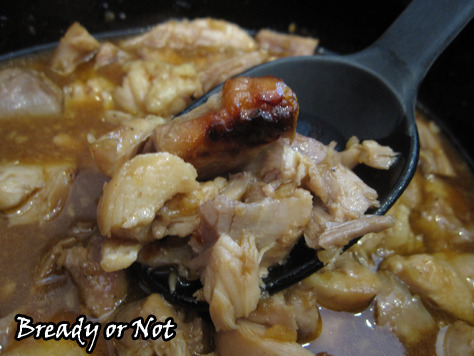

If you're not from around Seattle, that last point might come as a surprise. The simple fact is, almost every strip mall in that part of Washington has a teriyaki restaurant. These are the sort of mom-and-pop places that supply delicious meat by the bucket (i.e. a Styrofoam take-out box) and likely offer all sorts of other delights like sushi or gyoza, all of it addictive, affordable, and fast.
Around Arizona, it's easy to find good Mexican restaurants. Asian food... not so much. Therefore, when we get that craving for teriyaki, the best thing is just to make it at home. This recipe does the trick.
If only vivid green fields and soft rains could be conjured so easily...

Crock Pot Honey Sesame Chicken
modified from Table for Two
Ingredients:
1 lb boneless & skinless chicken thighs, about 5
Salt and pepper
1 cup honey
1/2 cup low sodium soy sauce
1/4 cup ketchup
2 Tb vegetable oil
2 cloves garlic, minced
1/2 cup diced onion or 1 Tb dry minced onion
1/4 tsp red pepper flakes
Cornstarch
Sesame seeds
Instructions:
1) Place the chicken thighs in the crock pot insert and sprinkle salt and pepper on both sides.

2) In a medium sized bowl, combine honey, soy sauce, ketchup, oil, garlic, onion, and red pepper flakes. Stir to combine. Pour over the chicken in the slow cooker.

3) Cook on low for 3-4 hours or high for 1 1/2-2 1/2 hours. [I used the 4-hour HIGH setting, and my chicken was done in 2 hours.]
4) When done, remove chicken from crock pot and cut into chunks. Prior to putting the chicken back in the pot, combine some cornstarch in water and whisk it to thicken up the sauce. Throw the chicken back in and stir around to recoat the chicken.
5) Serve hot over a bed of rice or noodles and sprinkle some sesame seeds on top.
OM NOM NOM.

Published on August 28, 2013 06:00
August 25, 2013
Sunday Quote is ready for winter about now
"View procrastinating simply as part of your creative process. That you’re not really avoiding writing so much as thinking about it, shaping it in your head, crystalizing it, before you actually sit down to do it." -Michael Geffner
Published on August 25, 2013 06:00
August 23, 2013
Worldcon 2013
Next weekend, I'll be attending one of the biggest genre conventions around: Worldcon in San Antonio. I fly in Thursday afternoon and will leave midday Monday. From the look of things, the days in between will be cram-packed with panels and socializing. I'm lucky that I already know a lot of people who will be there and I fully plan to shadow some kind folks who will (I hope) help draw me out of my introvert shell.
I do plan on bringing cookies--specifically, gingerbread bars. I will be wearing a badge that says CODEX COOKIE BRIGADE. If I am wearing the badge, that means you should feel free to stop me and ask for some gingerbread. So long as food is allowed in the location, I'll gladly oblige. Please, don't be shy! I love feeding people.
I wasn't given any panels at the con, but I already have sketchy plans that have the weekend entirely booked. I won't list the panels where I'll just be an audience member. Here are places where you can definitely find me and where I may be free to chat:
Friday
Codex Breakfast, location undetermined
09:00-10:00
Saturday
SFWA Meeting
10:00-Noon
Drinking with Authors, Ernie's Bar
19:00-whenever
Sunday
Strolling with the Stars
09:00-10:00
Codex BBQ dinner
06:00
[I don't plan to attend the Hugo ceremony--I just want to hang out with folks!]
Monday
Strolling with the Stars
09:00-10:00
I do plan on bringing cookies--specifically, gingerbread bars. I will be wearing a badge that says CODEX COOKIE BRIGADE. If I am wearing the badge, that means you should feel free to stop me and ask for some gingerbread. So long as food is allowed in the location, I'll gladly oblige. Please, don't be shy! I love feeding people.
I wasn't given any panels at the con, but I already have sketchy plans that have the weekend entirely booked. I won't list the panels where I'll just be an audience member. Here are places where you can definitely find me and where I may be free to chat:
Friday
Codex Breakfast, location undetermined
09:00-10:00
Saturday
SFWA Meeting
10:00-Noon
Drinking with Authors, Ernie's Bar
19:00-whenever
Sunday
Strolling with the Stars
09:00-10:00
Codex BBQ dinner
06:00
[I don't plan to attend the Hugo ceremony--I just want to hang out with folks!]
Monday
Strolling with the Stars
09:00-10:00
Published on August 23, 2013 07:47
August 21, 2013
Bready or Not: Orange Knots
Oranges are an awesome fruit. They taste fresh and great. They can be juiced. Their zest adds flavor oomph. Plus, oranges can be used as missiles.
Edible projectiles! What more can you ask for?
Well, how about an orange-flavored bread that comes together like a dream (a high calorie, delicious dream) and creates something that's downright pretty?
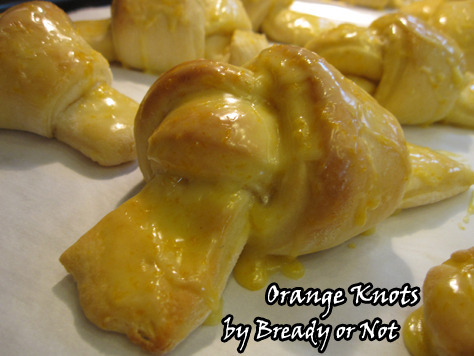
I am really in awe of how well this recipe turned out. I make a lot of bread. This particular dough was super-easy to work with--soft, pliable, and not even sticky. It rose well.
Then there's the glaze. It's delicious. Like, "lick the bowl clean even though the sugar makes my teeth hurt."
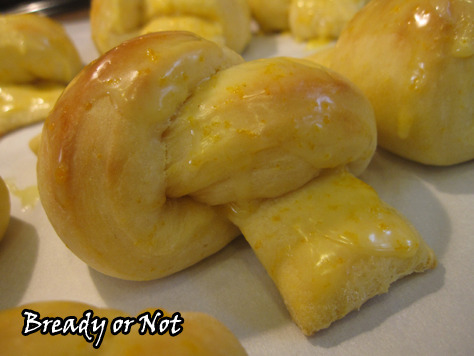
One caveat: like glazed donuts, these are best when the glaze is fresh that first day. After that, the glaze will crackle and ooze.
So, consider yourself warned. You have one day to eat all of these. BEGIN.
Seriously, the dough is so soft and delicious, I can see this being used as a base for all sorts of things, like cinnamon rolls, swirled loaf bread, monkey bread, etc. Or switch out lemon for orange. So many possibilities, so much sugar...
Orange Knots
from The Baker Upstairs
for the rolls:
5 1/4 to 5 3/4 cups Flour
2 1/4 teaspoons (1 packet) dry yeast
1 1/4 cups milk
1/2 cups butter
1/3 cups sugar
1/2 teaspoon salt
2 eggs
2 tablespoon finely grated orange peel
1/4 cup orange juice
for the glaze:
1 1/2 cups powdered sugar
1 1/2 teaspoons finely grated orange peel
2-3 tablespoons orange juice
1) In the bowl of a stand mixer or a large mixing bowl, combine flour and yeast.
2) In a large measuring cup or microwave safe bowl, combine milk, butter, sugar, and salt, and heat in the microwave for one minute, or until milk is slightly warm and butter just starts to melt.
3) Add milk mixture to flour mixture and stir. Add eggs, orange juice, and orange peel, and stir until combined. Gradually add remaining flour, until the dough begins to pull away from the sides of the bowl, and is just slightly sticky to the touch.
4) Let rise one hour, or until doubled in size. Separate dough into two equal-sized pieces, and let rest ten minutes.
5) Preheat oven to 400 degrees. Spray two baking sheets with cooking spray or line with parchment paper. Roll each piece of dough into a long rectangle, about 12 x 6 inches.
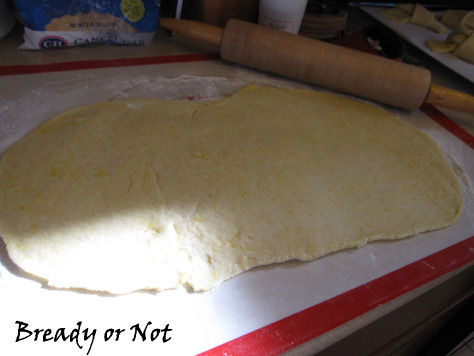
6) Cut each rectangle into twelve pieces, one inch wide and six inches long. (Don't stress. It's okay if they aren't equal.) Tie each into a loose knot, and place on baking sheet. Let rise on warm oven until nearly doubled, about half an hour.
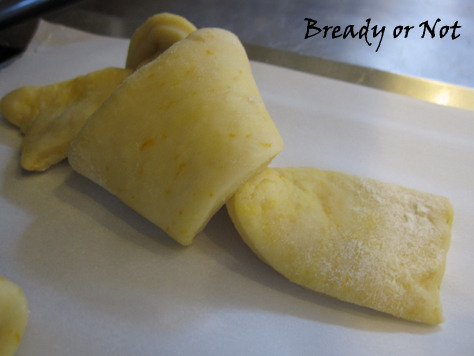
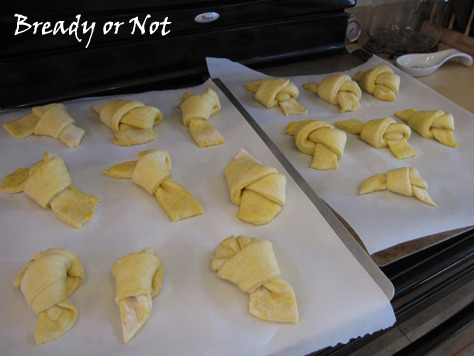
7) Bake 10-15 minutes, or until lightly browned.
8) While the rolls are baking, make the glaze. Whisk together powdered sugar, orange peel, and orange juice in a small bowl until well mixed. Brush over the rolls immediately after removing from the oven.
With the glaze, the rolls are best the first day. Without the glaze, they will last longer or can even be frozen.
OM NOM NOM.
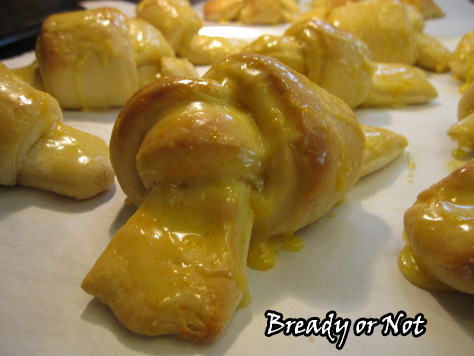
Edible projectiles! What more can you ask for?
Well, how about an orange-flavored bread that comes together like a dream (a high calorie, delicious dream) and creates something that's downright pretty?

I am really in awe of how well this recipe turned out. I make a lot of bread. This particular dough was super-easy to work with--soft, pliable, and not even sticky. It rose well.
Then there's the glaze. It's delicious. Like, "lick the bowl clean even though the sugar makes my teeth hurt."

One caveat: like glazed donuts, these are best when the glaze is fresh that first day. After that, the glaze will crackle and ooze.
So, consider yourself warned. You have one day to eat all of these. BEGIN.
Seriously, the dough is so soft and delicious, I can see this being used as a base for all sorts of things, like cinnamon rolls, swirled loaf bread, monkey bread, etc. Or switch out lemon for orange. So many possibilities, so much sugar...
Orange Knots
from The Baker Upstairs
for the rolls:
5 1/4 to 5 3/4 cups Flour
2 1/4 teaspoons (1 packet) dry yeast
1 1/4 cups milk
1/2 cups butter
1/3 cups sugar
1/2 teaspoon salt
2 eggs
2 tablespoon finely grated orange peel
1/4 cup orange juice
for the glaze:
1 1/2 cups powdered sugar
1 1/2 teaspoons finely grated orange peel
2-3 tablespoons orange juice
1) In the bowl of a stand mixer or a large mixing bowl, combine flour and yeast.
2) In a large measuring cup or microwave safe bowl, combine milk, butter, sugar, and salt, and heat in the microwave for one minute, or until milk is slightly warm and butter just starts to melt.
3) Add milk mixture to flour mixture and stir. Add eggs, orange juice, and orange peel, and stir until combined. Gradually add remaining flour, until the dough begins to pull away from the sides of the bowl, and is just slightly sticky to the touch.
4) Let rise one hour, or until doubled in size. Separate dough into two equal-sized pieces, and let rest ten minutes.
5) Preheat oven to 400 degrees. Spray two baking sheets with cooking spray or line with parchment paper. Roll each piece of dough into a long rectangle, about 12 x 6 inches.

6) Cut each rectangle into twelve pieces, one inch wide and six inches long. (Don't stress. It's okay if they aren't equal.) Tie each into a loose knot, and place on baking sheet. Let rise on warm oven until nearly doubled, about half an hour.


7) Bake 10-15 minutes, or until lightly browned.
8) While the rolls are baking, make the glaze. Whisk together powdered sugar, orange peel, and orange juice in a small bowl until well mixed. Brush over the rolls immediately after removing from the oven.
With the glaze, the rolls are best the first day. Without the glaze, they will last longer or can even be frozen.
OM NOM NOM.

Published on August 21, 2013 06:00
August 18, 2013
Sunday Quote goes to Bradbury for advice
"There are worse crimes than burning books. One of them is not reading them." ~Ray Bradbury
Published on August 18, 2013 06:00
August 16, 2013
An Interview with Sara Dobie Bauer, Author of LIFE WITHOUT HARRY
I know a some seriously awesome writers. Sara is a real life friend of mine. Our husbands actually work together. She has ingested my baking. But more pertinent for this blog, she's a fabulous writer with a new book that's available for free. I'll let her tell you all about it!

- Who are you?
I’m an author and book nerd. My work has previously appeared in The Gila River Review, Canyon Voices, and Traveler Magazine, and I volunteer monthly at Perryville Prison, where I run a women’s book club. I’m originally from the Midwest (I attended Ohio University), but I’ve been in Phoenix for three years. Its culture, climate, and atmosphere have greatly influenced my work (especially Dia de Los Muertos). When not writing, I drink IPA, watch bad horror films, and practice yoga—not necessarily in that order.
- Can you describe Life Without Harry?
My novel pays homage to Harry Potter, the city of Phoenix, and my Uncle Barney, who died suddenly in Bali in 2008. About the book: Xanax-dependent author Samantha Elliot is on deadline with a literary festival three weeks away when a white owl flies into her windshield and then disappears. This wouldn’t be the strangest thing, if not for the magic wand that soon shows up and the Invisibility Cloak that just happens to make Sam invisible. Then, there’s Paul Rudolph: the office crush who finally asks her on a date. With the help of anti-depressants and her friend, Julie, Sam must navigate an ever-escalating world of Harry Potter and an ever-hotter relationship with Paul while finishing a manuscript before her agent (who might be Voldemort) arrives for the literary festival … and possibly Sam’s head.
- The book isn't fan fiction, but it's so heavily inspired by Rowling's work that you weren't able to publish it traditionally. Therefore, you're giving it away. To me, this is a savvy, doing-it-for-the-love kind of act, a way of bonding with other Harry Potter fans who feel a sense of loss because the series is done. Was the writing process cathartic in that regard?
Following the midnight showing of the final Harry Potter film, I was depressed for days. I’m talking curled into fetal position depressed. I’d always wanted to live in the world of Harry Potter—go to Hogwarts, own a wand, and most importantly, fly on a broomstick. Suddenly, Harry was gone. I suppose I’d also never dealt emotionally with the loss of my Uncle Barney. So I woke one morning and started writing Life without Harry. I invented an imaginary world in which Sam becomes fully immersed in Harry’s magic realm … and gets the opportunity to see her beloved uncle one last time.
- I have to ask--who did the cover? It's gorgeous!
Katie (Stout) Purcell. We’ve known each other since grade school. We used to sneak cigarettes after swim practice as teens. Who knew we’d one day grow up to be functioning adults?
- What would you do if you saw a vanishing owl?
Have another drink.
- Do you have any other projects you'd like to talk about?
I finished my most recent novel, Damned if They Don’t, in March. Damned takes place in my previous city of habitation: the romantic and humid Charleston, South Carolina. A story of violin music, she-devils, and last chances, I’m hoping to sell it to an agent soon.
- How can folks get a copy of Life Without Harry?
Go here. And prepare to practice your spell-casting.

Thanks, Sara!

- Who are you?
I’m an author and book nerd. My work has previously appeared in The Gila River Review, Canyon Voices, and Traveler Magazine, and I volunteer monthly at Perryville Prison, where I run a women’s book club. I’m originally from the Midwest (I attended Ohio University), but I’ve been in Phoenix for three years. Its culture, climate, and atmosphere have greatly influenced my work (especially Dia de Los Muertos). When not writing, I drink IPA, watch bad horror films, and practice yoga—not necessarily in that order.
- Can you describe Life Without Harry?
My novel pays homage to Harry Potter, the city of Phoenix, and my Uncle Barney, who died suddenly in Bali in 2008. About the book: Xanax-dependent author Samantha Elliot is on deadline with a literary festival three weeks away when a white owl flies into her windshield and then disappears. This wouldn’t be the strangest thing, if not for the magic wand that soon shows up and the Invisibility Cloak that just happens to make Sam invisible. Then, there’s Paul Rudolph: the office crush who finally asks her on a date. With the help of anti-depressants and her friend, Julie, Sam must navigate an ever-escalating world of Harry Potter and an ever-hotter relationship with Paul while finishing a manuscript before her agent (who might be Voldemort) arrives for the literary festival … and possibly Sam’s head.
- The book isn't fan fiction, but it's so heavily inspired by Rowling's work that you weren't able to publish it traditionally. Therefore, you're giving it away. To me, this is a savvy, doing-it-for-the-love kind of act, a way of bonding with other Harry Potter fans who feel a sense of loss because the series is done. Was the writing process cathartic in that regard?
Following the midnight showing of the final Harry Potter film, I was depressed for days. I’m talking curled into fetal position depressed. I’d always wanted to live in the world of Harry Potter—go to Hogwarts, own a wand, and most importantly, fly on a broomstick. Suddenly, Harry was gone. I suppose I’d also never dealt emotionally with the loss of my Uncle Barney. So I woke one morning and started writing Life without Harry. I invented an imaginary world in which Sam becomes fully immersed in Harry’s magic realm … and gets the opportunity to see her beloved uncle one last time.
- I have to ask--who did the cover? It's gorgeous!
Katie (Stout) Purcell. We’ve known each other since grade school. We used to sneak cigarettes after swim practice as teens. Who knew we’d one day grow up to be functioning adults?
- What would you do if you saw a vanishing owl?
Have another drink.
- Do you have any other projects you'd like to talk about?
I finished my most recent novel, Damned if They Don’t, in March. Damned takes place in my previous city of habitation: the romantic and humid Charleston, South Carolina. A story of violin music, she-devils, and last chances, I’m hoping to sell it to an agent soon.
- How can folks get a copy of Life Without Harry?
Go here. And prepare to practice your spell-casting.

Thanks, Sara!
Published on August 16, 2013 06:01
August 15, 2013
Interview over on the WOW! Muffin Blog
When I set out to be a writer a few years ago, WOW! Women on Writing was a huge support for me. I had a story place runner-up in one of their flash fiction contests in 2008--one of my very first publications! After that, I was part of their Premium Green group. I was a total newbie to publishing and short story submissions. They sent me lists of new markets every month and put up with my clueless questions, and yet they always treated me with dignity and respect.
Therefore, it's extra cool to be interviewed on their Muffin Blog about the book deal. It's one of those weird moments where I feel like I've come full circle.
Therefore, it's extra cool to be interviewed on their Muffin Blog about the book deal. It's one of those weird moments where I feel like I've come full circle.
Published on August 15, 2013 07:46
August 14, 2013
Bready or Not: Shokupan (Japanese-style Milk Bread)
I bake a lot, but I bake sandwich bread most often of all--twice a week, sometimes more often. It started as a rebellion against rising prices on bread at the store, and now it's totally become a matter of taste. I simply can't eat enriched white bread anymore--I can taste the chemicals and blandness of it.
This particular recipe has become one of my staples. I have some other excellent recipes that call for dried milk powder, and a big favorite that uses sour cream. This recipe, though, is a great way to use up milk.

Shokupan is known in Japan as a super-soft white bread. That's exactly what this recipe makes. The bread may be soft, but it's also strong, and holds up well to tough stuff like peanut butter.
I found the original recipe on La Fuji Mama and discovered it made a loaf that was way too small for my liking. Therefore, I doubled the measurements and added vital wheat gluten, and ta-da! A perfect loaf.
I've made this with and without the added gluten, and that extra ingredient does make a difference in the rise. You can find gluten by the flour at most any grocery store, or you can go hardcore like me and buy it by the tub on Amazon. It may take me two years to use it all, but I will use it.
I make an awful lot of bread that tastes really, really good.

Milk Shokupan (Japanese-style white sandwich bread)
modified from La Fuji Mama
Ingredients:
3 1/3 cups bread flour
2 teaspoons vital wheat gluten
1/4 cup white sugar
1 packet (2 1/4 teaspoon) active dry yeast
2 teaspoons salt
1 1/2 cups milk
Butter to brush on top, optional
1) Measure out the milk and warm it in the microwave until it's about 90-100 degrees.
2) If you're using a bread machine, add the ingredients in the recommended order and run on dough cycle or full bread mode. I prefer to do dough cycle and bake in the oven.
If you're using a stand mixer, blend milk and sugar. In a separate bowl, combine gluten, flour, salt, and yeast. Mix wet and dry ingredients together and knead with a dough hook.
Either method: Keep an eye on the texture. If it's wet or too tacky, add more flour. If it's too dry, splash in a tiny bit more milk as needed.
2) Let dough rise until it has doubled, 1-2 hours. Grease or non-stick spray a bread pan.
3) Lightly grease a surface and dump your dough onto it. With your greased hands, form the dough into a loaf shape by gently folding. Set in the pan--or glop it in, and smooth it out (that's still a professional method, I think). Cover with lightly greased plastic wrap or a shower cap.
4) Let dough rise in a warm spot until it's crested to desired height, 30-60 minutes. Watch it. If the dough is heavier on milk, it will give it less structure as it rises, and it could overflow the pan.
5) Preheat oven to 350-degrees.
6) Bake bread for 20 minutes. Cover the top with foil to prevent heavy browning, then bake for an additional 15-20 minutes. When it's done, it'll sound hollow when tapped.
7) Remove bread from oven and hold it over a rack so it will gently drop out; use a spatula to carefully loosen it, if needed. If you want, you can brushed the top with some butter to soften the crust and give it a shine.
Let the bread cool at least 45 minutes before cutting. Also, you can let it cool completely and then wrap it several layers of plastic wrap before placing it in the freezer. Keeps well in freezer up to one month.
OM NOM NOM.

This particular recipe has become one of my staples. I have some other excellent recipes that call for dried milk powder, and a big favorite that uses sour cream. This recipe, though, is a great way to use up milk.

Shokupan is known in Japan as a super-soft white bread. That's exactly what this recipe makes. The bread may be soft, but it's also strong, and holds up well to tough stuff like peanut butter.
I found the original recipe on La Fuji Mama and discovered it made a loaf that was way too small for my liking. Therefore, I doubled the measurements and added vital wheat gluten, and ta-da! A perfect loaf.
I've made this with and without the added gluten, and that extra ingredient does make a difference in the rise. You can find gluten by the flour at most any grocery store, or you can go hardcore like me and buy it by the tub on Amazon. It may take me two years to use it all, but I will use it.
I make an awful lot of bread that tastes really, really good.

Milk Shokupan (Japanese-style white sandwich bread)
modified from La Fuji Mama
Ingredients:
3 1/3 cups bread flour
2 teaspoons vital wheat gluten
1/4 cup white sugar
1 packet (2 1/4 teaspoon) active dry yeast
2 teaspoons salt
1 1/2 cups milk
Butter to brush on top, optional
1) Measure out the milk and warm it in the microwave until it's about 90-100 degrees.
2) If you're using a bread machine, add the ingredients in the recommended order and run on dough cycle or full bread mode. I prefer to do dough cycle and bake in the oven.
If you're using a stand mixer, blend milk and sugar. In a separate bowl, combine gluten, flour, salt, and yeast. Mix wet and dry ingredients together and knead with a dough hook.
Either method: Keep an eye on the texture. If it's wet or too tacky, add more flour. If it's too dry, splash in a tiny bit more milk as needed.
2) Let dough rise until it has doubled, 1-2 hours. Grease or non-stick spray a bread pan.
3) Lightly grease a surface and dump your dough onto it. With your greased hands, form the dough into a loaf shape by gently folding. Set in the pan--or glop it in, and smooth it out (that's still a professional method, I think). Cover with lightly greased plastic wrap or a shower cap.
4) Let dough rise in a warm spot until it's crested to desired height, 30-60 minutes. Watch it. If the dough is heavier on milk, it will give it less structure as it rises, and it could overflow the pan.
5) Preheat oven to 350-degrees.
6) Bake bread for 20 minutes. Cover the top with foil to prevent heavy browning, then bake for an additional 15-20 minutes. When it's done, it'll sound hollow when tapped.
7) Remove bread from oven and hold it over a rack so it will gently drop out; use a spatula to carefully loosen it, if needed. If you want, you can brushed the top with some butter to soften the crust and give it a shine.
Let the bread cool at least 45 minutes before cutting. Also, you can let it cool completely and then wrap it several layers of plastic wrap before placing it in the freezer. Keeps well in freezer up to one month.
OM NOM NOM.

Published on August 14, 2013 06:00
August 11, 2013
Sunday Quote tries to do all the things
"I never hit a shot, not even in practice, without having a very sharp, in-focus picture of it in my head. First I see the ball where I want it to finish, nice and white and sitting up high on the bright green grass. Then the scene quickly changes, and I see the ball going there: its path, trajectory, and shape, even its behavior on landing. Then there is a sort of fade-out, and the next scene shows me making the kind of swing that will turn the previous images into reality." ~Jack Nicklaus
Published on August 11, 2013 06:01
August 9, 2013
Lucky Streaks
I've commented before on how acceptances seem to hit in a flood. There will be nothing for weeks, maybe even months, and then a succession of three or so may hit within a week--and often the publications will occur in little batches, too. It's odd.
But it feels even odder to me when other people comment on it. "Wow, you're on a roll!" "That's some lucky streak you're on!"
In my head, I kinda agree, but I also know about all the stuff that the public doesn't see.
As writers with work on submissions, we're not supposed to talk about how many rejections a project has. This is true of poetry, stories, novels, whatever. It's just not professional. An editor doesn't need to know a story was rejected XX times.
Yes, I have had a number of amazing acceptances this year. I've also had far, far more rejections. Very few pieces get accepted on the first submission. Some stories and poems have been kept in circulation for year or more. One story accepted this year had been sent around for almost two years; it sold for pro rates in the end.
I write a lot. I try to create a few new stories a month. I'm able to market most of them. I had 10-15 stories in circulation for a while and now the numbers have dipped because I didn't produce as much while I worked on Breath of Earth. When something is rejected, I try to send it out again as soon as possible. The more I send out, the more likely something will sell.
There is a lot of luck involved in the publishing process. It means surviving the fickleness of email inboxes and hard drives, finding the right slush reader, catching the editor in the right mood and without a migraine.
But there's also a lot I can control. I write. I submit. I keep submitting. I grouse and cry and revise and eat chocolate and submit again, again, again.
Sometimes, I make my own luck.
But it feels even odder to me when other people comment on it. "Wow, you're on a roll!" "That's some lucky streak you're on!"
In my head, I kinda agree, but I also know about all the stuff that the public doesn't see.
As writers with work on submissions, we're not supposed to talk about how many rejections a project has. This is true of poetry, stories, novels, whatever. It's just not professional. An editor doesn't need to know a story was rejected XX times.
Yes, I have had a number of amazing acceptances this year. I've also had far, far more rejections. Very few pieces get accepted on the first submission. Some stories and poems have been kept in circulation for year or more. One story accepted this year had been sent around for almost two years; it sold for pro rates in the end.
I write a lot. I try to create a few new stories a month. I'm able to market most of them. I had 10-15 stories in circulation for a while and now the numbers have dipped because I didn't produce as much while I worked on Breath of Earth. When something is rejected, I try to send it out again as soon as possible. The more I send out, the more likely something will sell.
There is a lot of luck involved in the publishing process. It means surviving the fickleness of email inboxes and hard drives, finding the right slush reader, catching the editor in the right mood and without a migraine.
But there's also a lot I can control. I write. I submit. I keep submitting. I grouse and cry and revise and eat chocolate and submit again, again, again.
Sometimes, I make my own luck.
Published on August 09, 2013 13:24



